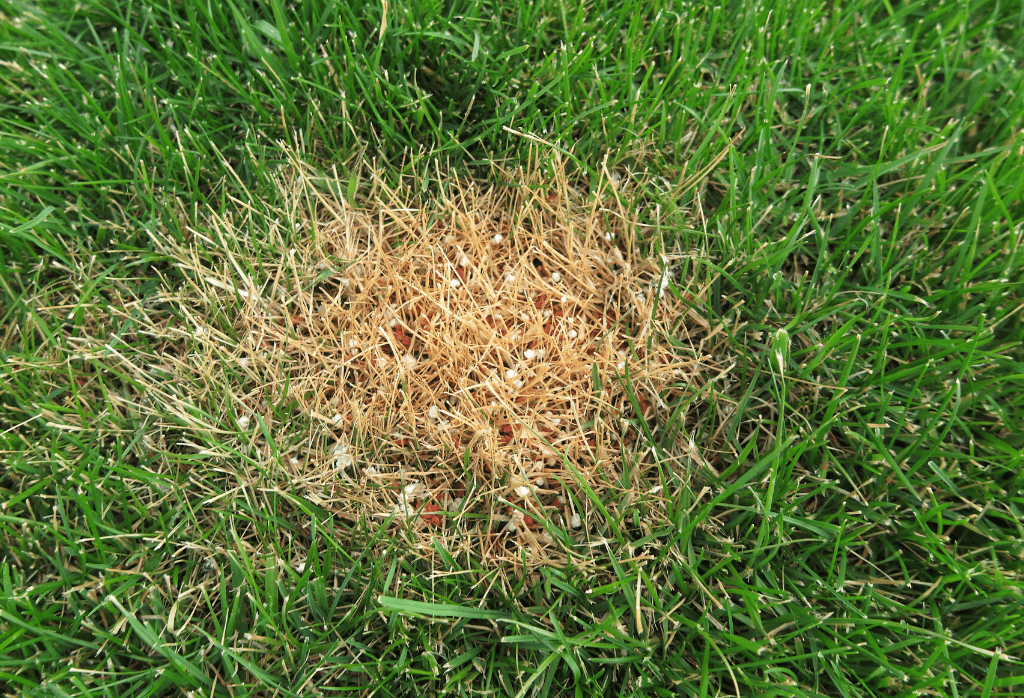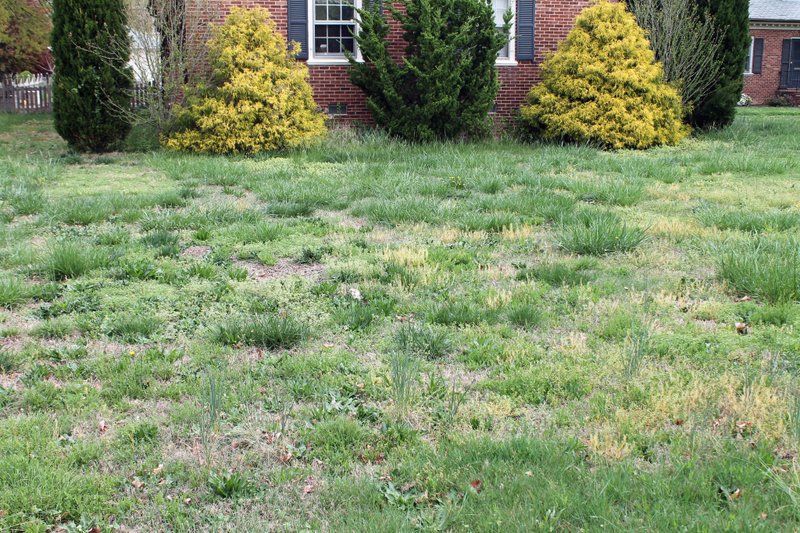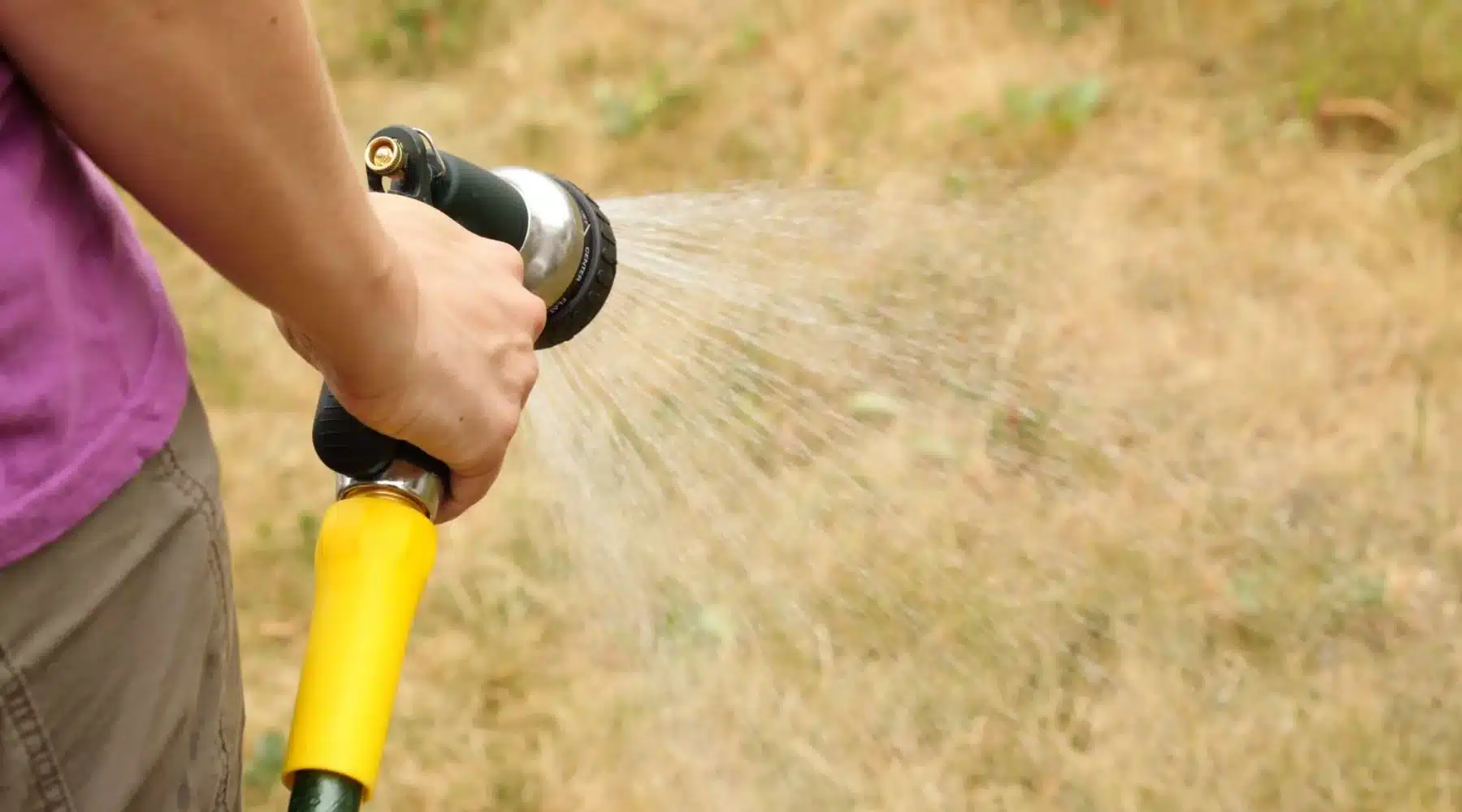I. Understanding the Problem: Dead Grass from Fertilizer
Dead grass from fertilizer is a common issue faced by many homeowners and gardeners. While fertilizer is essential for promoting healthy growth and vibrant green color in lawns, improper application or excessive use can lead to the death of grass. Understanding the problem is crucial in order to effectively address and fix the issue.
When fertilizer is applied incorrectly or in excessive amounts, it can cause chemical burns on the grass blades and roots. This burn damages the grass tissues, leading to discoloration, wilting, and ultimately, death. Additionally, certain types of fertilizers contain high levels of salts, which can also harm the grass if not properly diluted or flushed out.
It is important to note that dead grass from fertilizer may not be immediately noticeable. The damage may take some time to become apparent, often appearing as patches or areas of thinning grass. These areas may turn yellow or brown, indicating the presence of dead or dying grass.
To fix dead grass from fertilizer, it is crucial to follow a systematic approach that involves removing excess fertilizer residue, flushing the affected areas with water, aerating and overseeding, and adopting proper fertilizer application techniques. By addressing the issue promptly and taking preventive measures, it is possible to revive the grass and achieve a lush and healthy lawn.
Common Causes of Dead Grass from Fertilizer
Dead grass from fertilizer application can be a frustrating problem for homeowners who are trying to maintain a lush and healthy lawn. Understanding the common causes of this issue can help you prevent it from happening in the future.
1. Overapplication: Applying too much fertilizer can burn the grass and cause it to die. It is important to follow the recommended application rates and avoid excessive use of fertilizer.
2. Uneven Application: Uneven distribution of fertilizer can result in some areas receiving too much while others receive too little. This can lead to dead patches of grass in certain areas of the lawn.
3. Incorrect Timing: Applying fertilizer at the wrong time can also contribute to dead grass. Fertilizing during periods of drought or extreme heat can stress the grass and cause it to die.
4. Using the Wrong Type of Fertilizer: Different types of grass require different types of fertilizer. Using the wrong type can harm the grass and result in dead patches.
5. Fertilizer Spills: Accidental spills or concentrated areas of fertilizer can cause localized damage to the grass, resulting in dead spots.
To prevent dead grass from fertilizer, it is important to carefully follow the instructions on the fertilizer packaging, use the correct type of fertilizer for your grass, and apply it evenly and at the appropriate time. Regularly monitoring your lawn for signs of overapplication or uneven distribution can also help prevent this issue.

III. Assessing the Damage: Identifying Dead Grass Areas
Before you can begin fixing the dead grass caused by fertilizer, it’s important to assess the extent of the damage and identify the areas that need attention. Here are some steps to help you assess the damage:
- Inspect your lawn: Take a close look at your entire lawn and identify areas where the grass appears brown, dry, or completely dead. These areas are likely the ones that have been affected by the fertilizer.
- Check for fertilizer residue: Look for any visible signs of excess fertilizer residue on the grass blades or soil surface. This can indicate over-application or improper spreading techniques.
- Perform a tug test: Gently tug on the grass blades in the affected areas. If they come out easily or have shallow root systems, it’s a sign that the grass is dead.
- Observe growth patterns: Compare the growth patterns of the affected areas with the healthy parts of your lawn. Dead grass areas may have stunted or no growth at all.
By carefully assessing the damage, you’ll have a better understanding of the areas that require your attention and the severity of the problem. This will help you determine the appropriate steps to take in order to fix the dead grass caused by fertilizer.
Steps to Fix Dead Grass from Fertilizer
When faced with dead grass caused by fertilizer, it is important to take immediate action to revive your lawn and restore its health. Follow these steps to fix dead grass from fertilizer:
Step 1: Remove Excess Fertilizer Residue
The first step in fixing dead grass from fertilizer is to remove any excess fertilizer residue that may be present on the surface of your lawn. Use a rake or a leaf blower to gently remove the residue without causing further damage to the grass.
Step 2: Watering and Flushing the Affected Areas
Next, thoroughly water the affected areas to flush out any remaining fertilizer from the soil. This will help dilute the concentration of the fertilizer and prevent further damage to the grass. Ensure that the water penetrates the soil deeply to reach the roots of the grass.
Step 3: Aeration and Overseeding
Aerate the affected areas using a garden fork or a mechanical aerator. This will help improve the soil’s ability to absorb water and nutrients, promoting healthy grass growth. After aerating, overseed the damaged areas with grass seed to encourage new growth and fill in the bare spots.
Step 4: Proper Fertilizer Application Techniques
To prevent future damage to your lawn, it is crucial to follow proper fertilizer application techniques. Read and follow the instructions on the fertilizer packaging carefully, ensuring that you apply the correct amount and at the right time. Avoid over-fertilizing, as this can lead to excessive nutrient buildup and harm the grass.
Preventing Dead Grass from Fertilizer in the Future
To maintain a lush and healthy lawn, it is important to practice proper lawn care techniques. This includes regular mowing, watering, and fertilizing. Ensure that you choose a fertilizer specifically formulated for your grass type and apply it according to the recommended schedule. Regularly monitor your lawn for signs of nutrient deficiencies or excesses and adjust your fertilization practices accordingly.
Conclusion: Achieving a Lush and Healthy Lawn
By following these steps and implementing proper lawn care practices, you can fix dead grass caused by fertilizer and restore your lawn to its former glory. Remember to be patient, as it may take some time for the grass to fully recover. With consistent care and maintenance, you can achieve a lush and healthy lawn that will be the envy of your neighborhood.

Step 1: Remove Excess Fertilizer Residue
When dealing with dead grass caused by fertilizer, the first step is to remove any excess fertilizer residue from the affected areas. This is important because excess fertilizer can continue to harm the grass and prevent it from recovering.
To remove the excess fertilizer, start by using a rake or a broom to gently sweep away any visible residue on the surface of the grass. Be careful not to be too aggressive, as this can further damage the grass.
Next, use a garden hose or a sprinkler to thoroughly water the affected areas. This will help to dilute and wash away any remaining fertilizer that may be present in the soil. Make sure to water the grass evenly and avoid overwatering, as this can lead to other issues such as fungal diseases.
After watering, allow the grass to dry completely before moving on to the next step. This will ensure that the excess fertilizer has been effectively removed and that the grass is ready for the next phase of repair.
By removing excess fertilizer residue, you are taking the necessary first step towards reviving your dead grass and setting the stage for successful repair.
Step 2: Watering and Flushing the Affected Areas
Watering and flushing the affected areas is an essential step in fixing dead grass caused by fertilizer. This process helps to dilute and remove excess fertilizer residue from the soil, allowing the grass to recover and grow again.
Here are the steps to properly water and flush the affected areas:
- Water the area: Start by thoroughly watering the affected areas. This will help to flush out any excess fertilizer and prevent further damage to the grass.
- Use a garden hose: Attach a garden hose with a sprinkler attachment to ensure even watering. Move the sprinkler around the affected areas to ensure that all parts receive sufficient water.
- Water deeply: Water the affected areas deeply to ensure that the water reaches the roots of the grass. This will help to promote healthy root growth and aid in the recovery process.
- Monitor the soil: Keep an eye on the soil moisture levels. If the soil becomes too saturated, adjust the watering schedule accordingly to prevent overwatering.
- Repeat the process: Repeat the watering and flushing process regularly, especially during dry periods, to ensure that the grass receives adequate moisture and the fertilizer residue is gradually flushed out.
Remember to water the entire lawn regularly, not just the affected areas, to maintain overall lawn health and prevent further damage. Additionally, consider using a slow-release fertilizer in the future to minimize the risk of over-fertilization and potential damage to the grass.
By following these steps and providing proper watering and flushing, you can help revive your dead grass and restore it to a lush and healthy state.

Step 3: Aeration and Overseeding
One effective method to fix dead grass from fertilizer is through aeration and overseeding. Aeration involves creating small holes in the soil to improve air circulation, water absorption, and nutrient penetration. This process helps to alleviate soil compaction and allows the grass roots to grow deeper.
To aerate your lawn, you can use a manual or mechanical aerator. Simply walk over the affected areas, ensuring that the aerator penetrates the soil to a depth of at least 2-3 inches. This will create the necessary channels for air, water, and nutrients to reach the grass roots.
After aerating, it is crucial to overseed the dead grass areas. Overseeding involves spreading grass seeds over the existing lawn to promote new growth and fill in the bare patches. Choose a high-quality grass seed that is suitable for your climate and lawn conditions.
Before overseeding, make sure to remove any debris or dead grass from the affected areas. This will provide a clean and favorable environment for the new grass seeds to germinate and establish. You can use a rake or a specialized dethatching tool to remove the dead grass and create a smooth surface.
Once the dead grass has been cleared and the soil has been aerated, spread the grass seeds evenly over the affected areas. Lightly rake the seeds into the soil to ensure good seed-to-soil contact. Water the overseeded areas regularly to keep the soil moist and promote germination.
It is important to note that overseeding may require multiple applications to achieve the desired results. Be patient and consistent with your lawn care efforts, as it may take several weeks for the new grass to establish and fill in the dead areas.
By aerating and overseeding, you can effectively revive your lawn and promote the growth of healthy grass in the areas affected by fertilizer damage. This step, combined with proper watering and fertilization techniques, will help you achieve a lush and vibrant lawn.
Step 4: Proper Fertilizer Application Techniques
One of the key factors in preventing dead grass from fertilizer is using proper application techniques. Here are some guidelines to follow:
1. Read and follow the instructions: Before applying any fertilizer, carefully read the instructions provided by the manufacturer. Different fertilizers may have specific application rates and methods, so it’s important to follow them accurately.
2. Use a spreader: To ensure even distribution of the fertilizer, use a spreader instead of applying it by hand. This will help prevent over-application in certain areas, which can lead to burning and killing the grass.
3. Calibrate the spreader: Before using the spreader, calibrate it according to the instructions provided. This will help you determine the correct setting for the desired application rate. Adjust the spreader accordingly to avoid under or over-fertilizing the lawn.
4. Apply during the right time: Timing is crucial when it comes to fertilizer application. Avoid applying fertilizer during periods of extreme heat or drought, as this can stress the grass and increase the risk of damage. Instead, choose a time when the grass is actively growing and the weather conditions are favorable.
5. Water after application: After applying the fertilizer, water the lawn thoroughly. This will help the nutrients penetrate the soil and reach the grass roots. It will also dilute any excess fertilizer and prevent it from burning the grass.
By following these proper fertilizer application techniques, you can minimize the risk of dead grass and promote a healthy and vibrant lawn.
IX. Preventing Dead Grass from Fertilizer in the Future
Preventing dead grass from fertilizer in the future requires proper lawn care practices and careful application of fertilizers. By following these steps, you can maintain a healthy and lush lawn without causing damage:
1. Choose the right fertilizer: Select a fertilizer that is suitable for your specific grass type and the needs of your lawn. Different grass species have different nutrient requirements, so it’s important to choose a fertilizer that provides the necessary nutrients without causing excessive growth or damage.
2. Read and follow the instructions: Always read the instructions on the fertilizer packaging and follow them carefully. Pay attention to the recommended application rates and timing. Over-fertilizing can lead to burning and killing of the grass, so it’s crucial to apply the fertilizer as directed.
3. Use a spreader: To ensure even distribution of the fertilizer, use a spreader instead of applying it by hand. This will help prevent concentrated areas of fertilizer that can burn the grass. Follow the manufacturer’s instructions for the proper settings and technique when using the spreader.
4. Water properly: After applying fertilizer, water your lawn thoroughly to help the nutrients penetrate the soil and prevent burning. Watering also helps to flush any excess fertilizer away from the grass blades. Avoid watering too frequently or too little, as both can lead to grass damage.
5. Maintain proper mowing height: Keep your grass at the recommended mowing height for its specific species. Cutting the grass too short can weaken it and make it more susceptible to damage from fertilizer. Regular mowing at the correct height promotes healthy growth and reduces the risk of dead grass.
6. Soil testing: Periodically test your soil to determine its nutrient levels and pH. This will help you understand the specific needs of your lawn and allow you to adjust your fertilizer application accordingly. Soil testing can also identify any imbalances or deficiencies that may be contributing to grass damage.
By following these preventive measures, you can minimize the risk of dead grass from fertilizer and maintain a vibrant and healthy lawn. Remember to always prioritize proper lawn care practices and be mindful of the specific needs of your grass species.
X. Conclusion: Achieving a Lush and Healthy Lawn
Dead grass caused by fertilizer application can be a frustrating problem for homeowners. However, with the right steps and proper lawn care techniques, you can revive your lawn and achieve a lush and healthy landscape. By following the steps outlined in this guide, you can effectively fix dead grass from fertilizer and prevent future damage.
First and foremost, it is important to understand the common causes of dead grass from fertilizer. Overapplication, uneven spreading, and using the wrong type of fertilizer can all contribute to grass damage. By being mindful of these factors, you can avoid unnecessary harm to your lawn.
Assessing the damage is crucial in order to identify the areas of dead grass. This will help you determine the extent of the problem and focus your efforts on the affected areas. Once you have identified the dead grass areas, you can proceed with the necessary steps to fix the damage.
The first step in fixing dead grass from fertilizer is to remove any excess fertilizer residue. This can be done by gently raking the affected areas to remove the buildup. It is important to be careful not to damage the healthy grass surrounding the dead patches.
Next, watering and flushing the affected areas is essential to dilute and remove any remaining fertilizer. This will help to prevent further damage and promote the growth of new grass. Adequate watering is crucial during this stage to ensure proper hydration for the recovering grass.
Aeration and overseeding are important steps in the recovery process. Aeration helps to improve soil compaction and allows for better nutrient absorption. Overseeding helps to fill in the dead patches with new grass, promoting a fuller and healthier lawn.
Proper fertilizer application techniques are key to preventing future damage. It is important to follow the instructions on the fertilizer packaging and apply it evenly and at the recommended rate. Additionally, regular maintenance practices such as mowing at the correct height and watering appropriately will contribute to the overall health of your lawn.
In conclusion, fixing dead grass from fertilizer requires a systematic approach and proper lawn care techniques. By removing excess fertilizer residue, watering and flushing the affected areas, aerating and overseeding, and practicing proper fertilizer application techniques, you can revive your lawn and achieve a lush and healthy landscape. With consistent maintenance and care, you can prevent future damage and enjoy a beautiful lawn for years to come.
